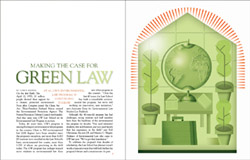Making the Case for Green Law
At 40, GW’s environmental law program is continuing to grow
On the first Earth Day, April 22, 1970, 20 million people showed their support for a cleaner, protected environment. Soon after, Congress passed the Clean Air Act. Then-President Richard Nixon created the Environmental Protection Agency. The Natural Resources Defense Council was founded. And that same year, GW Law School set its Environmental Law Program in motion.
Today, 40 years later, GW’s program is among the largest environmental law programs in the country. Close to 900 environmental law LLM degrees have been awarded since the program’s inception, and more than 4,000
JD students have enrolled in the Law School’s basic environmental law course, more than 1,000 of whom are practicing in the field today. The GW program has perhaps trained more students in environmental law than
any other program in the country. “Over the last 40 years, the Law School has built a remarkable environmental law program, but we’re still working on innovative, new initiatives,” says Associate Dean for Environmental Law Studies Lee Paddock.
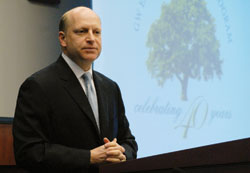
Gary Guzy, deputy director of the White House Council on Environmental Quality, was the keynote speaker at the 2010 J.B. and Maurice C. Shapiro Environmental Law Conference on Feb. 18 and 19. The conference was co-sponsored by the The George Washington University Law School, the Environmental Law Institute, GW Environmental Law Association, and the Journal of Energy and Environmental Law.
Although the 40-year-old program has had challenges, strong students and staff members have been the backbone of the environmental law program for decades. “You need interested students, first and foremost, and you need faculty that has experience in the field,” says Rob Glicksman, the new J.B. and Maurice C. Shapiro Professor of Environmental Law who came to GW last year. “We’ve got that foundation.”
To celebrate the program’s four decades of scholarship, the Law School has planned a year’s worth of special events that will both further the program’s future and commemorate its past.
Marking the Occasion
At the two-day 2010 J.B. and Maurice C. Shapiro Environmental Law Conference, held in February 2010, faculty members and special guests examined environmental implications of moving from fossil fuel-based energy sources to alternative energy sources. “The law can either facilitate or create obstacles to the development of alternative energy,” Mr. Glicksman explains. “One example is tax legislation; Congress can pass legislation that provides tax credits for reductions for businesses that install alternative energy sources or that create new technologies for distribution of energy.” Keynote speaker Gary Guzy, deputy director and general counsel for the White House Council on Environmental Quality, recalls that in 1970 the environment was an afterthought, but soon after, there was the recognition of significant environmental concerns that has led us to the robust environmental efforts of today.
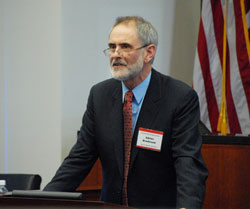
Professor Adrian Bradbrook of University of Adelaide Law School was a panelist discussing the international context for next generation energy.
The crowning event of the year will be the autumn anniversary reunion, which promises to include an event on the Greening of GW; lunch at the nearby American Institute of Architects; and a roundtable discussion involving former professor Arnold Reitze, the long-time leader of the environmental law program and graduates of the GW environmental law program who now teach environmental law at other universities..
Looking Back
In 1970, Associate Dean Ralph Nash helped GW become one of three law schools—with Colorado and UCLA—to receive funding from the Ford Foundation to set up environmental law programs. The lion’s share of the funds came to GW Law School, amounting to some $250,000. The grant provided the funding needed to bring Arnold Reitze, who had previously taught environmental law at Case Western Reserve University in Ohio, to GW. He arrived on campus during the summer of 1970. The Law School already had an established land use program, led by Jim Brown, and an energy program headed by Herald Greene. Professor Reitze helped launch the environmental law program and then led the program for 38 years. “Arnold is one of the foundering fathers of environmental law,” Dean Paddock says. Arnold created one of the first LLM programs in the country soon after arriving at GW and, to support the program, recruited a number of environmental law luminaries in the region, a practice that continues today. The program that evolved under professor Reitze’s direction focused primarily on pollution control. After Mr. Greene and Mr. Brown retired, professor Reitze expanded the program to include a focus on energy.
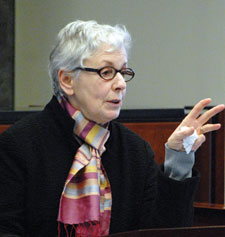
Johanna Wald, senior attorney for the Natural Resources Defense Council, was part of a panel discussing “Environmental Impacts of Renewable Energy Development: Can We Do It Right?”
In the early days, the fledgling environmental program “was humongous,” professor Reitze says. “The largest classroom in the school held 160 students, and it wasn’t unusual for that class to have a waiting list.” Professor Reitze taught the basic environmental class as a day class but had an additional 70 to 80 night students for a second introductory class. Professor Reitze also taught a natural resources class and a water law class.
In the early 1970s, environmental concerns hinged largely on the most basic issues of pollution control, professor Reitze says. Before that time, a large number of cities dumped sewage into local waterways with no treatment. “We didn’t have water pollution control until the late 1960s, and there were essentially no air pollution controls except for municipal laws,” professor Reitze says. California, he explains, was ahead of the curve with developing an environmental law body. As a result, large amounts of federal money went toward building sewage treatment plants in the early 1970s. “For a number of years, that was the second largest domestic program for infrastructure after highway building,” professor Reitze says.
In the 1980s, “the country had changed dramatically,” professor Reitze says. The first and second Arab petroleum cutoff in 1973 and 1979 had led to a recession. The Federal government became less supportive of environmental issues, professor Reitze says, and the focus for environmental law shifted away from air and water to hazardous waste management and cleanup.
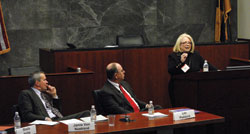
James Von Nostrand, executive director of the Pace Energy and Climate Center at Pace Law School; Lee Paddock, GW associate dean for Environmental Law; and Sheila Hollis of Duane Morris discussed the legal and policy framework for energy efficiency at the conference.
Among the law program’s greatest challenges, remembers professor Reitze, was operating on a tight budget. When the Ford Foundation grant ended in 1975, the program relied on its adjunct professors. Fortunately, GW’s prime location meant the program could tap into D.C.’s immense legal talent, drawing in some of the best environmental lawyers in the country to teach as adjunct professors. “We had very loyal adjuncts, some of who taught for decades,” including Lance Wood, Sheila Hollis, Tom Mounteer, and other top practitioners of environmental law, he says. “The adjuncts were the reason we had the best faculty in the country.”
As the Department of Defense became more focused on the significant impacts its operations had on the environment, the GW environmental law program also became a the place where Judge Advocate Generals’ lawyers and their civilian counterparts learned environmental law. “We had a very significant influence on the development of the environmental ethic by the Department of Defense,” professor Reitze says. “We also trained civilian lawyers for the Army Corp of Engineers and played a role in its move from a development-oriented organization to one highly involved in the protection of wetlands and water resources.” About 200 Department of Defense attorneys—mainly with the Navy, Air Force, and Marines—received their Masters Degree in Environmental Law at GW, Dean Paddock adds
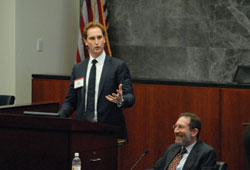
GW Law student David Frenkil discussed energy efficiency in government as Steven Schooner, co-director of GW Law’s government procurement law program, moderated the panel.
Professor Reitze remained at GW Law School until 2008, and these days, he teaches at the University of Utah’s law school and is an active member of The Institute for Clean and Secure Energy, a think tank operating in the Department of Chemical of Engineering. In his place, professor Glicksman stepped into the J.B. and Maurice C. Shapiro Professor of Environmental Law position (see sidebar).
The Program Today
Building on the strong foundation created by professor Reitze, the GW environmental law program continues to expand its reach. The arrival of professor Rob Glicksman, one of the most prolific environmental law scholars, added important depth to the environmental law program.
The program will publish the first issue of its new Journal of Energy and Environmental Law this summer. The journal will be one of only a handful of law journals that will include a focus on energy law, an increasingly important field of law as the country shifts to greater reliance on alternative forms of energy. The journal will be published in collaboration with the Environmental Law Institute and distributed to subscribers of the Environmental Law Reporter News & Analysis, in addition to journal subscribers. The journal revives a tradition of publishing an environmental journal at GW. For several years, professor Reitze oversaw the publication of the Environmental Lawyer. That publication ended in 2003.
“There are not a lot of energy law publications, and we want to fill what we believe is an underserved area of study,” says third-year law student Trevor Salter, the new editor-in-chief. “Renewable energy projects, too, are taking a front seat in the nation’s discourse, and energy law is becoming a more important field.” The second edition, slated for the fall, will feature articles by the energy symposium’s speakers.
New to the Environmental Law Program in 2010 are the J.B. and Maurice C. Shapiro Congressional Fellowships, which offer third-year students opportunities to participate directly in the making of environmental law. Student Derek Hanson worked in Sen. Amy Klobuchar’s (D-Minn.) office during the spring semester; another student will work in Sen. Frank Lautenberg’s (D-N.J.) office this summer. During the semester, students are eligible for a half-tuition scholarship; during the summer, students get a $15,000 payment. “The program allows students to get real, hands-on experience with environmental legislation,” Dean Paddock says.
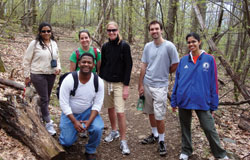
Environmental Law Association members Yamuna Kumaraswamy, Katie Lannon, Emily Hildreth, Andy Byrne, Lillian Marquez, and Marc Bennett hike at Shenandoah National Park, Va. (above right) The new student-managed Journal of Energy and Environmental Law
Courtesy Jessica Katz
“My biggest project has been working on a soon-to-be introduced environmental bill,” says professor Hanson, who has worked extensively with the developers of the original working drafts of environmental bills, helping comb through subsequent drafts and respond to comments that ensure that the bill works from the legal perspective. “This is a very different perspective from which to look at legal issues, as usually in law school and legal practice you’re looking at laws already passed and trying to figure out how to make sense of them,” professor Hanson says.
New experiences in international law, too, will strengthen the program. GW Law recently signed a student exchange agreement with the University of Groningen in the Netherlands, which has been rated as the number one law school in the Netherlands. The exchange agreement allows up to four students to visit each semester. The first Dutch students are expected to come to GW Law this fall.
“When students are considering a law school, one of the most frequent questions is about international exchange opportunities. The agreement with Groningen expands the study abroad opportunities for our students,” Dean Paddock says. “Environmental law is increasingly an international issue. Students need to understand what’s happening in the European Union and in other parts of the world; you can learn that here on campus, but you can experience it there. U.S. companies that want to sell products in the E.U. have to know E.U. law now because it’s different and often more stringent than U.S. laws. More and more products have to be designed to E.U. standards to be sold in Europe,” Dean Paddock says.
GW law students also have the option to study abroad in Canada and Mexico. GW is one of only a few U.S. law schools that is a member of the North American Consortium of Legal Education, established in the aftermath of the North American Free Trade Agreement.
Equipping Future Eco-Lawyers
The experiences of third-year law student Jessica Katz, president of the Environmental Law Association, attests to the program’s success in helping students become involved in the practice of environmental law in D.C. Ms. Katz worked as a research assistant for professor Amy Stein during the time that professor Stein taught legal writing at GW. Ms. Katz was able to use her expertise in the National Environmental Policy Act to investigate deeper into whether climate change has a cumulative impact that should be considered in environmental impact statements.
“All the professors have so many contacts,” says Ms. Katz, who interned for the Council of Environmental Quality and worked with the administrative law judges at the Environmental Protection Agency. While environmental law students from throughout the country compete for internships during the summer, the same organizations and agencies need assistance during the academic year. This situation provides a real advantage for students attending GW; they are able to almost literally walk across the street to their internships.
As GW continues to strengthen and grow the program, both faculty members and students benefit from the strong foundation built over the past 40 years. With an unequaled environmental alumni network, an expansive curriculum supported by both full-time faculty and stellar adjunct faculty, opportunities to publish leading edge scholarly articles, new study abroad options, and the chance to gain work experience at some of the most important environmental organizations in the world, the GW Environmental Law Program is laying a new foundation for the next 40 years.
Glicksman Joins Environmental Law Faculty
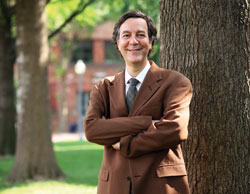 Nick Gingold
Nick Gingold Professor Robert Glicksman, a nationally and internationally recognized expert on environmental, natural resources, property, and administrative law issues, succeeds Arnold Reitze as the J.B. and Maurice C. Shapiro Professor of Environmental Law. He teaches several environmental law courses, as well as Administrative Law and Property Law, on a rotating basis.
Before joining the GW Law faculty, professor Glicksman taught for 27 years at the University of Kansas School of Law, where he was the Robert W. Wagstaff Distinguished Professor of Law. Previously, professor Glicksman had practiced with a firm in D.C., focusing on environmental, energy, and administrative law issues and consulting on various environmental law issues, including work for the Secretariat of the Commission for Environmental Cooperation in Montreal.
Professor Glicksman’s list of publications in which he has been author and co-author includes Environmental Protection: Law and Policy (Aspen Publishers); Public Natural Resources Law (Thomson/West); Administrative Law: Agency Action in Legal Context (Foundation Press); Risk Regulation at Risk: A Pragmatic Approach (Stanford University Press); and Modern Public Land Law in a Nutshell (West Group). He is the co-author of a forthcoming book on environmental enforcement, which focuses on the Clean Water Act.
“When I went to law school, I thought I would do international law,” professor Glicksman says. But stronger inspiration came from time spent hiking in the Adirondack Mountains, where he learned the value and beauty of the outdoors firsthand. Growing up in Patterson, N.J., with a polluted river nurtured an early desire for environmental change. “When I took my first environmental law course, it really resonated with me,” says professor Glicksman, who is concerned about environmental health consequences for communities.
Last fall, professor Glicksman taught a class on toxic substances and hazardous waste regulation; this spring, he navigated a class through the Clean Air Act, including implications for climate change.
—Carrie Madren

